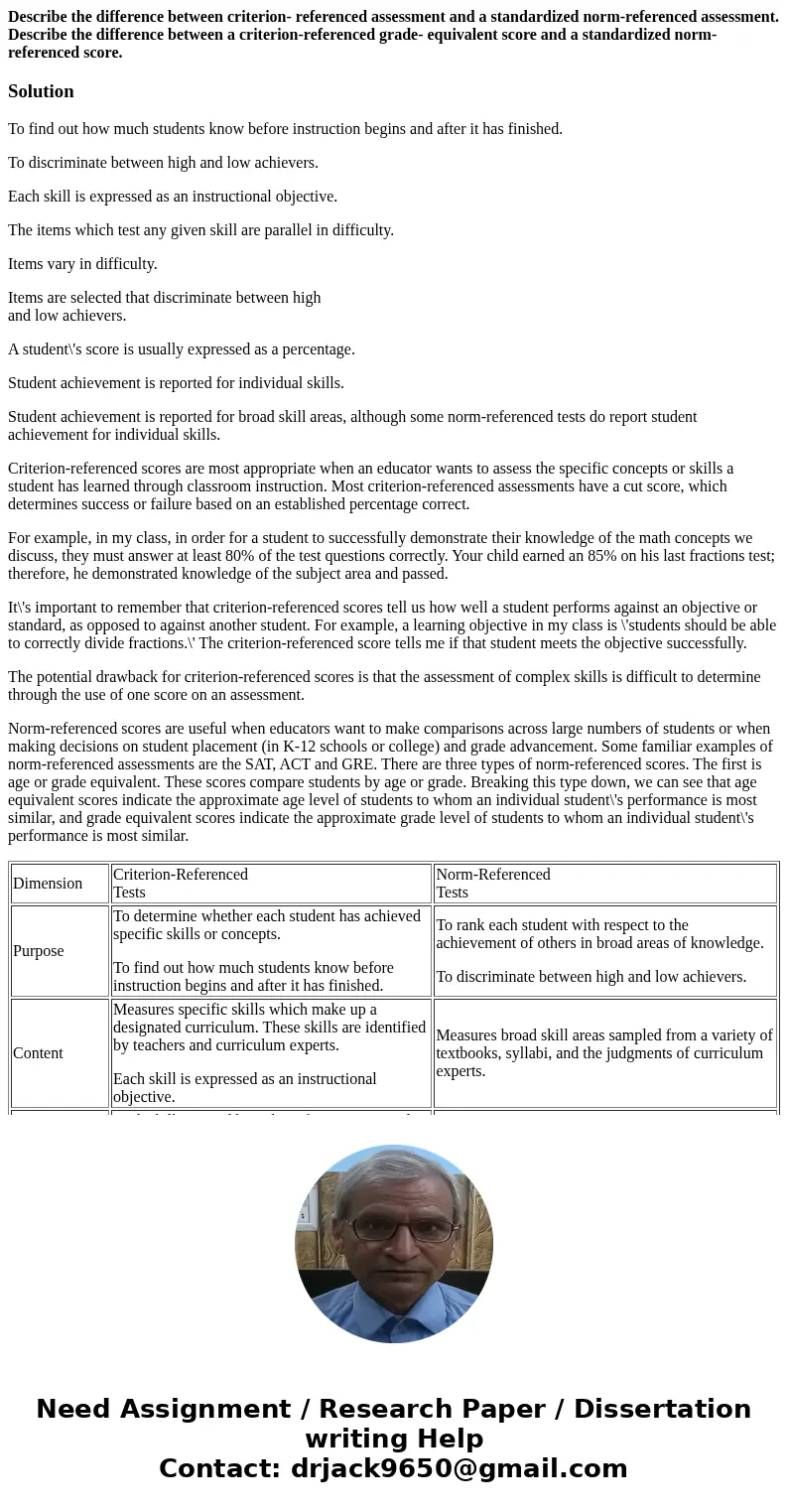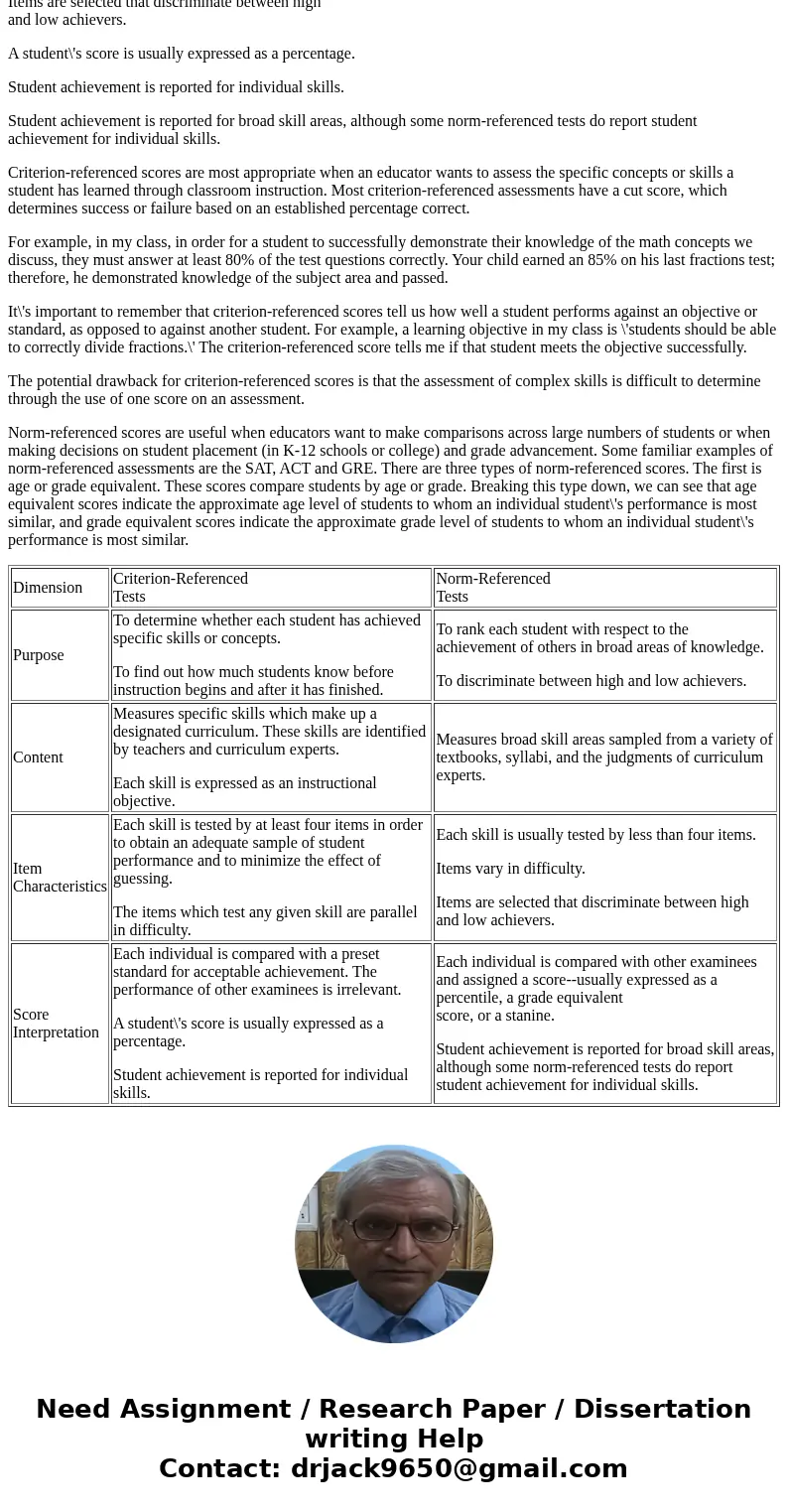Describe the difference between criterion referenced assessm
Describe the difference between criterion- referenced assessment and a standardized norm-referenced assessment. Describe the difference between a criterion-referenced grade- equivalent score and a standardized norm-referenced score.
Solution
To find out how much students know before instruction begins and after it has finished.
To discriminate between high and low achievers.
Each skill is expressed as an instructional objective.
The items which test any given skill are parallel in difficulty.
Items vary in difficulty.
Items are selected that discriminate between high
and low achievers.
A student\'s score is usually expressed as a percentage.
Student achievement is reported for individual skills.
Student achievement is reported for broad skill areas, although some norm-referenced tests do report student achievement for individual skills.
Criterion-referenced scores are most appropriate when an educator wants to assess the specific concepts or skills a student has learned through classroom instruction. Most criterion-referenced assessments have a cut score, which determines success or failure based on an established percentage correct.
For example, in my class, in order for a student to successfully demonstrate their knowledge of the math concepts we discuss, they must answer at least 80% of the test questions correctly. Your child earned an 85% on his last fractions test; therefore, he demonstrated knowledge of the subject area and passed.
It\'s important to remember that criterion-referenced scores tell us how well a student performs against an objective or standard, as opposed to against another student. For example, a learning objective in my class is \'students should be able to correctly divide fractions.\' The criterion-referenced score tells me if that student meets the objective successfully.
The potential drawback for criterion-referenced scores is that the assessment of complex skills is difficult to determine through the use of one score on an assessment.
Norm-referenced scores are useful when educators want to make comparisons across large numbers of students or when making decisions on student placement (in K-12 schools or college) and grade advancement. Some familiar examples of norm-referenced assessments are the SAT, ACT and GRE. There are three types of norm-referenced scores. The first is age or grade equivalent. These scores compare students by age or grade. Breaking this type down, we can see that age equivalent scores indicate the approximate age level of students to whom an individual student\'s performance is most similar, and grade equivalent scores indicate the approximate grade level of students to whom an individual student\'s performance is most similar.
| Dimension | Criterion-Referenced Tests | Norm-Referenced Tests |
| Purpose | To determine whether each student has achieved specific skills or concepts. To find out how much students know before instruction begins and after it has finished. | To rank each student with respect to the achievement of others in broad areas of knowledge. To discriminate between high and low achievers. |
| Content | Measures specific skills which make up a designated curriculum. These skills are identified by teachers and curriculum experts. Each skill is expressed as an instructional objective. | Measures broad skill areas sampled from a variety of textbooks, syllabi, and the judgments of curriculum experts. |
| Item Characteristics | Each skill is tested by at least four items in order to obtain an adequate sample of student performance and to minimize the effect of guessing. The items which test any given skill are parallel in difficulty. | Each skill is usually tested by less than four items. Items vary in difficulty. Items are selected that discriminate between high |
| Score Interpretation | Each individual is compared with a preset standard for acceptable achievement. The performance of other examinees is irrelevant. A student\'s score is usually expressed as a percentage. Student achievement is reported for individual skills. | Each individual is compared with other examinees and assigned a score--usually expressed as a percentile, a grade equivalent score, or a stanine. Student achievement is reported for broad skill areas, although some norm-referenced tests do report student achievement for individual skills. |


 Homework Sourse
Homework Sourse